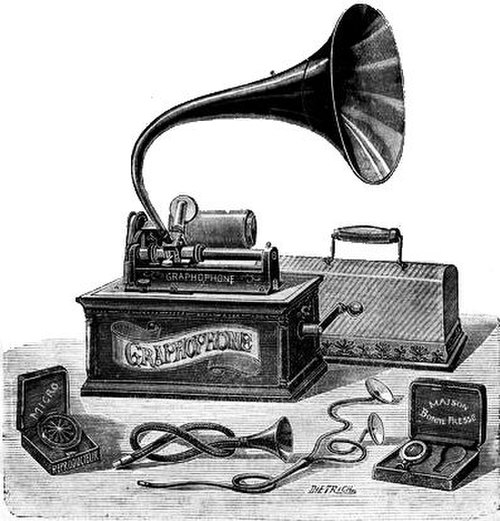Gramophonenoun
A record player.
Gramophonenoun
An instrument for recording, preserving, and reproducing sounds, the record being a tracing of a phonautograph etched in some solid material. Reproduction is accomplished by means of a system attached to an elastic diaphragm. This older term is almost completely replaced for modern devices by the word phonograph (or hi-fi), and technological changes have made the term sound antiquated, and it is usually used to refer to older non-electronic versions of the phonograph.
Gramophonenoun
an antique record player; the sound of the vibrating needle is amplified acoustically
Phonographnoun
A device that captures sound waves onto an engraved archive; a lathe.
Phonographnoun
A device that records or plays sound from cylinder records.
Phonographnoun
A record player.
Phonographnoun
(dated) A character or symbol used to represent a sound, especially one used in phonography.
Phonographverb
To record for playback by phonograph.
Phonographverb
To transcribe into phonographic symbols.
Phonographnoun
A character or symbol used to represent a sound, esp. one used in phonography.
Phonographnoun
An instrument for the mechanical registration and reproduction of audible sounds, as articulate speech, etc. It consists of a rotating cylinder or disk covered with some material easily indented, as tinfoil, wax, paraffin, etc., above which is a thin plate carrying a stylus. As the plate vibrates under the influence of a sound, the stylus makes minute indentations or undulations in the soft material, and these, when the cylinder or disk is again turned, set the plate in vibration, and reproduce the sound.
Phonographnoun
an instrument for reproducing sounds, especially music, previously recorded on a plastic cylinder or disk as a pattern of bumps or wiggles in a groove. A needle (stylus) held in the groove is made to vibrate by motion (rotation) of the recording, and the vibrations caused by the bumps and wiggles are transmitted directly to a membrane, or first to an electronic amplifier circuit, thereby reproducing with greater or less fidelity the original sounds. A phonograph which is equipped with electronics enabling the playback of sound with high fidelity to the original is often called a hi-fi.
Phonographnoun
machine in which rotating records cause a stylus to vibrate and the vibrations are amplified acoustically or electronically
Phonograph
A phonograph, in its later forms also called a gramophone (as a trademark since 1887, as a generic name in the UK since 1910) or since the 1940s called a record player, is a device for the mechanical recording and reproduction of sound. The sound vibration waveforms are recorded as corresponding physical deviations of a spiral groove engraved, etched, incised, or impressed into the surface of a rotating cylinder or disc, called a .






















